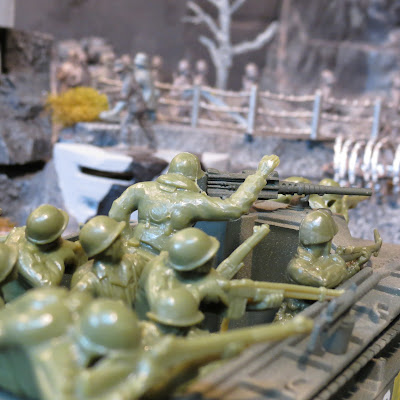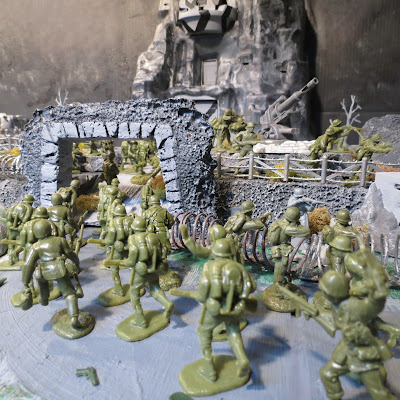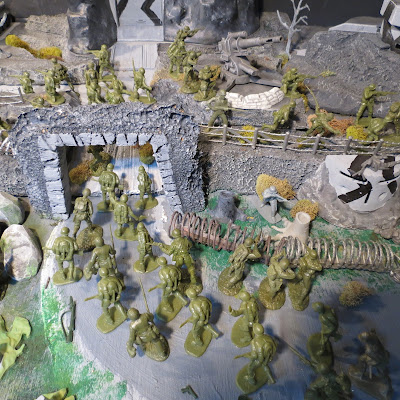Parting with their guide, and using stealth and concealment, the three commandos assess the best entry point to the enemy position.
Under the very guns of the Germans, the commandos begin their infiltration.
Evading all sentries, and leaving one man behind as a lookout, the captain and corporal, loaded down with thermite charges, make their stealthy way up the treacherous heights of Navarone mountain and the gun installation above.
Reaching an unguarded and seldom-used access door, the commandos enter the mountain complex. Using the diagram of the facility, the infiltrators find their way to the platform of the big guns.
Quiet as mice, and under the noses of two card-playing German coastal-artillery men, the commandos place timed thermite charges within the breech blocks of the mammoth cannons, set the timed fuzes, and retreat back into the shadows.
Effecting their escape from the complex, the Captain and corporal retrieve the lookout, and the trio follows their footsteps back down the the beach, their rafts, and to the eventual safety of the Vampire.
The immediate result was anticlimactic but decisive. Exactly one hour after setting the timers, the thermite charges ignited. The intense heat welded the moving parts of the breach blocks and rendered the iron giants helpless, harmless, and mute. Not only were the troops on Kheros potentially saved, but the exploit of the three commandos openes the island of Navarone up to a full sea-borne invasion.
At 0600 the invasion begins, with the first wave of LVTs and LVT(A)s hitting the beach at 0655. Serious, grim, determined, or frightened, the men of the 2nd Battalion of the 28th ("Keystone") Infantry Division, finally put all of their training to the test.
Part II. the invasion
"Away all boats, away" sounds from dozens of shipboard loudspeakers as scores of landing craft are released from the transports to make their way over one mile of open water to the beach,
At 1000 yards, German mortars open fire.
A 75mm LVT (A) is positioned in the lead to start hammering at obstacles when the first wave lands.
A 37mm "gun gator's" fire is ineffective while the vechicle wallows toward shore, nonetheless, an occasional round is fired inland, if only for the effect upon the morale of the men in the boats.
At a top speed of 15 knots, coxswains from the Navy and Coast Guard struggle to stay in formation.
The well of an LCM fills with exhaust as a Sherman tank roars to life,
First sergeant D'amico shouts last minute instructions to his squad before their LVT hits the beach.
All along the beach, ramps splash down and men charge through the surf.
A 37mm LVT(A) lays down covering fire.
Two more LVT(A)s follow-on and fan out.
The gunfire support LVTs are followed out of the surf by the alligators carrying infantrymen.
A Browning automatic rifle is brought to bear against German beach defenders.
A 37mm LVT (A) climbs out of the surf to soften a German pillbox.
The final 75mm LVT(A) waddles ashore to back up a 37mm, already in action.
Close behind the LVTs comes the second wave of LCVPs and LCMs carrying infantry, combat engineers, and tanks.
With the second wave, LCMs start to disgorge tanks and more troops.
Two Sherman tanks are knocked out by a concealed STUG
Two corporals take over the loading and firing of an LVT(A)-mounted 75mm gun after its crew is disabled, and bring fire to bear against the STUG.
The German defense is fierce and desperate.
German armor and reinforcements are called up.
Twenty-five minutes after the second wave, the third wave brings in more troops, artillery, ammunition, and US Navy Seabees.
German reinforcements pour into the front-line defensive positions.
A stalled LVT has to unload directly within the arc of fire of a German machine gun, casualties are high.
The two corporals who earlier clamberd aboard a disabled 75mm LVT to man the big gun, destroy the machinegun position and allowed evacuation of the American wounded. For this action, both will recieve the Bronze Star.
With the beach obstacles behind them, the Americans barely catch their breath before tackling the heights and the Germans above.
Part III. the brake-out
The breakout occurs at 0735
An American tank-destroyer takes out the deadly STUG.
The Americans pour an enormous volume of fire into the German positions.
Dogged pockets of German resistance become cut-off beyond the beach.
Supported by a tank-destroyer, a squad of GIs meets an enemy attempt to reinforce the German left flank and a desperate to drive the Americans back to the beach.
The German reinforcing attempt quickly crumbles under the blistering fire of the Americans.
The frantic Germans rain down grenades on the American juggernaut.
It is becoming apparent to the Germans that the waves of GIs may be unstoppable.
The LVTs have moved as far inland as the terrain allows. Soldiers dismount and face the heights and the Germans above.
German machine guns hammer away relentlessly, barely able to pause long enough to change out red-hot barrels
One last shot as a beach defender scrambles up the bluff to
make a stand in the inner defenses.
Part IV. the assault
A bazooka and flamethrower are brought to bear against a panzer which is desperately trying to stem the flood of determined G.I.s. as the main entrance to the German compound is rushed, and breached. The damaged, and smoldering, tank limps to temporary safety, and is abandoned.
The Germans put up a fanatic resistance, knowing that they are outnumbered, but determined to go down fighting.
A tank-destroyer clears the main gate and provides fire-support for the following wave of the men of the Keystone Division.
By now, the third wave has arrived, and the handwriting is on the wall for the Germans. They can slow the American juggernaut, but stopping it is out of the question.
The Germans pull back, an inch at at time from their prepared positions.
At the base of the mountain, the Americans place C-4 charges to to blow open the armored doors of the mountain complex, which only 24 hours prior, was considered impregnable.
The remaining pillbox on the left flank pins down an American squad.
The enemy machinegun fire temporarily halts a flank-attack by the Americans.
A flamethrower is summoned and makes quick work of the pillbox and the defenders within.
Desperate defenders, make last stands throughout the German complex.
Enemy soldiers fall in wind-rows in the face of terrific fire from the Americans.
Another flamethrower is deployed against one of the remaining bunkers.
Fanatics no more, Germans, in small pockets, are surrendering to the unstoppable Americans onslaught.
Well-placed shots pick off the remaining defenders as...
the German right flank is overwhelmed.
One of the few, remaining officers, a dyed-in-the-wool Nazi, organizes and directs the final stand of the remaining Germans. His squad of SS fanatics will shoot-down any German who breaks and runs.
The men of the second battalion converge from left and right and isolate one of the last pockets of German resistance.
Defenders are cleared from the top of the last remaining pillbox.
Pockets of enemy resistance have no choice but to surrender or die.
With the armored doors little more than smoking wreckage, the Americans flood the great strongpoint.
The mountain complex is now entirely in American hands.
In triumph, Americans take position on the highest gun-platform and take pot-shots at the retreating Germans.
The mop-up includes Germans being hustled to the beach for evacuation and POW camps. For the battered and resentful prisoners, the war has come to an end.
The clearing smoke reveals the price of fanaticism.
Part V. occupation
Within a week,the efforts of the Seabees transform the once indomitable German fortress into the first American operational base in the Aegean sea.
The men of the Keystone Division spend that week reorganizing and resting from their epic struggle.
Resupplied, and refitted, the GIs return to the beach to be taken back to the transport ships for their next battle. The Tommies on Kheros are saved, Turkish neutrality is assured, and the Germans are slowly being pushed out of the blue Aegean sea.
The miracle of Navarone was a strategic victory as well as a needed boost to the morale of the embattled allied forces in the region. From a dot on a map to a ringing victory, Navarone takes its place the annals of US Army and Navy history.
The End
Post-script
This project took inspiration from the film The Guns of Navarone. It's an exciting movie that has me on the edge of my seat at every viewing. It's worth a watch - you won't be disappointed. Do note though, that it's a work of fiction.
Production notes
Regular readers of this blog might know that the Navarone project started 4 years ago. I never know how long a project will take once I begin it, and this one has been occupying the toy soldier table since April of 2020.
A test of the backdrop reveals a convincing setting for the Marx mountain. The gaps and seams in the cardboard were edited out, or softened, using the rudimentary erasing feature.
before erasure
after erasure
A variety of manufacturers are represented in this battle. Marx provides many of the Germans, obstacles, trees, vehicles and other pieces. BMC is represented in the American forces and many of the vehicles, LCVPs, and LVTs. I was even able to trot out a childhood favorite - an MPC infantryman with removable silver helmet and rifle; it was nice to see these guys in action after so many decades since I was a kid.
BMCs excellent GIs provided most of the American soldiers. They have really stepped up their game in past years, as these soldiers are well sculpted, and imaginatively animated. Also, they are very accurate.
Some Trumpeter and Italeri (LVT(a)s and the LCM) as well as Tamiya (tank destroyer) are also in the mix. The mountain is, of course, the Marx Navarone mountain, and the terrian is made of styrofoam. The backdrop is acrylic paint on sheets of cardboard (see blue link at the very top of page)
These large scenarios are challenging and take muchf time to make happen: fortunately, I have two toy soldier tables, one is 6' x 4' surface and the smaller one is 8' x 2', the luxury of space allows me to occupy one for extended periods of time while still having the another for other scenarios.
This Navarone project was ambitious, fun, and satisfying, and makes me look forward to future larger projects (Did someone say "Battle of Guam"?).
All knocked-down and ready for the next big project.
For now, thanks for stopping by, and, as always...
Soldier on!
Mannie
p.s I'd love to hear from you!




























































.JPG)










































2 comments:
First rate story and set up. You have me inspired. Thank you
Howdy from Texas! Great job as usuual, Mannie. Even though the story is ficton, you still managed to give it an aura of Histor combined with toy soldier illustrations. Like your previous ACW history/diorama set ups about the sunken road and Burnsides' Bridge: top notch information with a fun nod to we toy sojer/ History buffs who tried to recreate these same scenarios in the backyard sandbox. I look forward to more posts -- especially the Guam project. **Be sure to use a 3-D printer to create a scale figure of yourself when you ere posted there... just an idea. :)
Post a Comment